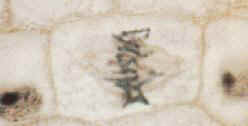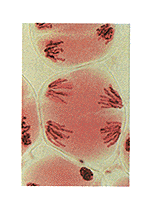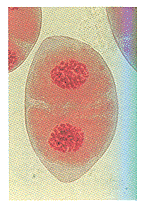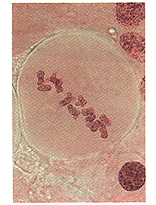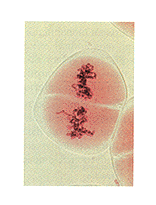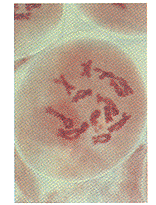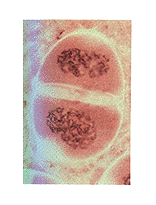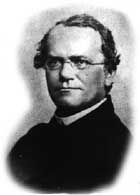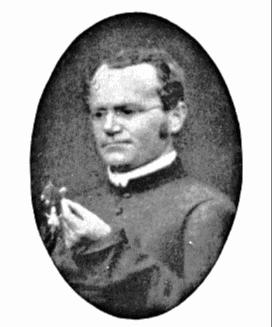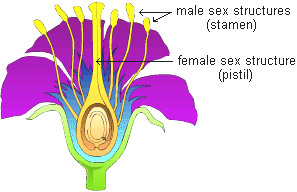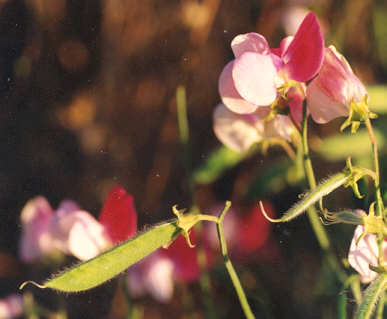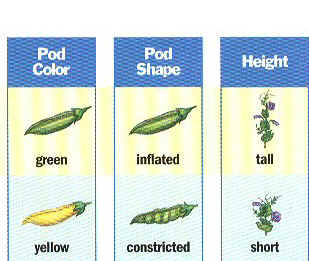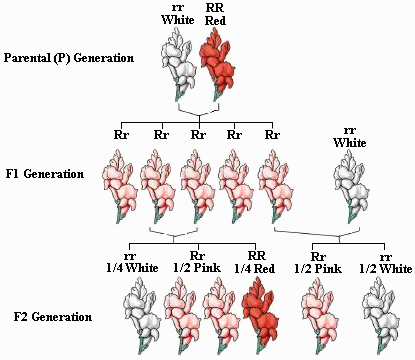| Stages of Mitosis |  |
Introduction
Mitosis, also called karyokinesis, is division of the nucleus and its chromosomes. It is followed by division of the cytoplasm known as cytokinesis. Both mitosis and cytokinesis are parts of the life of a cell called the Cell Cycle. Most of the life of a cell is spent in a non-dividing phase called Interphase. Interphase includes G1 stage in which the newly divided cells grow in size, S stage in which the number of chromosomes is doubled and appear as chromatin, and G2 stage where the cell makes the enzymes & other cellular materials needed for mitosis.
Mitosis has 4 major stages — Prophase, Metaphase, Anaphase, and Telophase. When a living organism needs new cells to repair damage, grow, or just maintain its condition, cells undergo mitosis.
During Prophase, the DNA and proteins start to condense. The two centrioles move toward the opposite end of the cell in animals or microtubules are assembled in plants to form a spindle. The nuclear envelope and nucleolus also start to break up.

Prophase
During Metaphase, the spindle apparatus attaches to sister chromatids of each chromosome. All the chromosomes are line up at the equator of the spindle. They are now in their most tightly condensed form.

Metaphase
During Anaphase, the spindle fibers attached to the two sister chromatids of each chromosome contract and separate chromosomes which move to opposite poles of the cell.

Anaphase
In Telophase, as the 2 new cells pinch in half (animal cells) or a cell plate forms (plant cells), the chromosomes become less condensed again and reappear as chromatin. New membrane forms nuclear envelopes and the nucleolus is reformed.

Telophase
Objective:
In this lab, you will determine the approximate time it takes for a cell to pass through each of the four stages of mitosis. You may use your textbook and class notes to help you identify the stages of mitosis as seen under the microscope.
Materials:
Microscope, prepared slide onion root tip or whitefish blastula, textbook, lab worksheet, pencil
Procedure:
- Set up a compound light microscope and turn on the light.
- Place a slide containing a stained preparation of the Allium (onion root tip) or Whitefish blastula.
- Locate the meristematic or growth zone, which is just above the root cap at the very end of the tip or
- Focus in on low power, and then switch to medium or high power. Below find micrographs of the four stages of mitosis. Use them to help you identify the stages on the microscope slide.
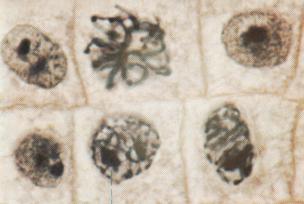
Prophase (onion)
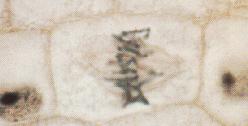
Metaphase (onion)
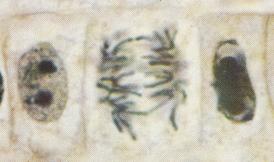
Anaphase (onion)

Telophase (whitefish)
- Now count the number of cells found in each stage of mitosis and place the data in the chart below.
- Determine the percentage of time each cell will spend in each stage of mitosis. Divide the number of each cell by the total number of cells and multiply by 100 to determine the percentage. Place these values in the chart below.
| Stage of Mitosis | Number of Cells | Percent of time in each stage = # of cells in stage X 100% |
| Prophase | % | |
| Metaphase | % | |
| Anaphase | % | |
| Telophase | % | |
| Interphase (Not a Mitotic Stage) | % | |
| Total # cells | 100% |
- Line graph the data you have just collected. Be sure to label the X and Y axis & include the units of measurement.
Title: __________________________________________________

Graph Legend:
Questions:
1. Of the four stages of mitosis, which one takes the most time to complete?
2. Which is the shortest stage in duration?
3. What would happen if the process of mitosis skipped metaphase? telophase?
Further Study:
Normal Cell Division may be observed in onion root tips. Many of the processes are similar to those in animal cells. However, in plant cells, the cell plate between daughter cells forms from the Golgi.

Find all of the stages of mitosis and interphase in the above picture. Make a sketch of each stage and briefly describe what is occurring. Count and record the number of cells you see in each stage.
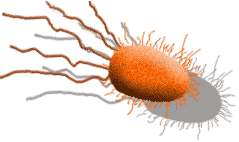 | Projects |
 | Notes |


